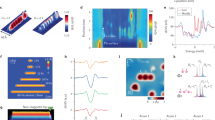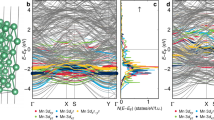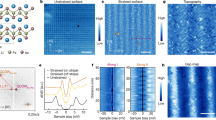Abstract
Majorana zero modes (MZMs) are emergent zero-energy topological quasiparticles that are their own antiparticles1,2. Detected MZMs are spatially separated and electrically neutral, so producing hybridization between MZMs is extremely challenging in superconductors3,4. Here, we report the magnetic field response of vortex bound states in superconducting topological crystalline insulator SnTe (001) films. Several MZMs were predicted to coexist in a single vortex due to magnetic mirror symmetry. Using a scanning tunnelling microscope equipped with a three-axis vector magnet, we found that the zero-bias peak (ZBP) in a single vortex exhibits an apparent anisotropic response even though the magnetic field is weak. The ZBP can robustly extend a long distance of up to approximately 100 nm at the (001) surface when the magnetic field is parallel to the (\(1\bar{1}0\))-type mirror plane, otherwise it displays an asymmetric splitting. Our systematic simulations demonstrate that the anisotropic response cannot be reproduced with trivial ZBPs. Although the different MZMs cannot be directly distinguished due to the limited energy resolution in our experiments, our comparisons between experimental measurements and theoretical simulations strongly support the existence and hybridization of symmetry-protected multiple MZMs. Our work demonstrates a way to hybridize different MZMs by controlling the orientation of the magnetic field and expands the types of MZM available for tuning topological states.
This is a preview of subscription content, access via your institution
Access options
Access Nature and 54 other Nature Portfolio journals
Get Nature+, our best-value online-access subscription
$32.99 / 30 days
cancel any time
Subscribe to this journal
Receive 51 print issues and online access
$199.00 per year
only $3.90 per issue
Buy this article
- Purchase on SpringerLink
- Instant access to full article PDF
Prices may be subject to local taxes which are calculated during checkout





Similar content being viewed by others
Data availability
The data supporting the findings of this study are presented within the paper and Supplementary Information. Source data are provided with this paper. Additional data are available from the corresponding authors upon reasonable request.
Code availability
The code for this paper is available from the corresponding authors upon reasonable request.
References
Qi, X.-L. & Zhang, S.-C. Topological insulators and superconductors. Rev. Mod. Phys. 83, 1057 (2011).
Beenakker, C. W. J. Search for Majorana fermions in superconductors. Annu. Rev. Condens. Matter Phys. 4, 113–136 (2013).
Albrecht, S. M. et al. Exponential protection of zero modes in Majorana islands. Nature 531, 206–209 (2016).
Schneider, L. et al. Precursors of Majorana modes and their length-dependent energy oscillations probed at both ends of atomic Shiba chains. Nat. Nanotechnol. 17, 384–389 (2022).
Mourik, V. et al. Signatures of Majorana fermions in hybrid superconductor-semiconductor nanowire devices. Science 336, 1003 (2012).
Nadj-Perge, S. et al. Observation of Majorana fermions in ferromagnetic atomic chains on a superconductor. Science 346, 602–607 (2014).
Jeon, S. et al. Distinguishing a Majorana zero mode using spin-resolved measurements. Science 358, 772–776 (2017).
Xu, J.-P. et al. Experimental detection of a Majorana mode in the core of a magnetic vortex inside a topological insulator-superconductor Bi2Te3/NbSe2 heterostructure. Phys. Rev. Lett. 114, 017001 (2015).
Sun, H.-H. et al. Majorana zero mode detected with spin selective Andreev reflection in the vortex of a topological superconductor. Phys. Rev. Lett. 116, 257003 (2016).
Wang, D. et al. Evidence for Majorana bound states in an iron-based superconductor. Science 362, 333–335 (2018).
Liu, Q. et al. Robust and clean Majorana zero mode in the vortex core of high-temperature superconductor (Li0.84Fe0.16)OHFeSe. Phys. Rev. X 8, 041056 (2018).
Li, M. et al. Ordered and tunable Majorana-zero-mode lattice in naturally strained LiFeAs. Nature 606, 890–895 (2022).
Haim, A. & Oreg, Y. Time-reversal-invariant topological superconductivity in one and two dimensions. Phys. Rep. 825, 1–48 (2019).
Valentini, M. et al. Majorana-like Coulomb spectroscopy in the absence of zero-bias peaks. Nature 612, 442–447 (2022).
Mier, C., Choi, D.-J. & Lorente, N. Moiré dispersion of edge states in spin chains on superconductors. Phys. Rev. Res. 4, L032010 (2022).
Kong, L. et al. Half-integer level shift of vortex bound states in an iron-based superconductor. Nat. Phys. 15, 1181–1187 (2019).
Machida, T. et al. Zero-energy vortex bound state in the superconducting topological surface state of Fe(Se,Te). Nat. Mater. 18, 811–815 (2019).
Qi, X.-L., Hughes, T. L., Raghu, S. & Zhang, S. C. Time-reversal-invariant topological superconductors and superfluids in two and three dimensions. Phys. Rev. Lett. 102, 187001 (2009).
Wong, C. L. M. & Law, K. T. Majorana Kramers doublets in \({d}_{{x}^{2}-{y}^{2}}\)-wave superconductors with Rashba spin–orbit coupling. Phys. Rev. B 86, 184516 (2012).
Zhang, F., Kane, C. L. & Mele, E. J. Time-reversal-invariant topological superconductivity and Majorana Kramers pairs. Phys. Rev. Lett. 111, 056402 (2013).
Zhang, F., Kane, C. L. & Mele, E. J. Topological mirror superconductivity. Phys. Rev. Lett. 111, 056403 (2013).
Liu, X.-J., He, J. J. & Law, K. T. Demonstrating lattice symmetry protection in topological crystalline superconductors. Phys. Rev. B 90, 235141 (2014).
Kobayashi, S. & Furusaki, A. Double Majorana vortex zero modes in superconducting topological crystalline insulators with surface rotation anomaly. Phys. Rev. B 102, 180505 (2020).
Fang, C., Gilbert, M. J. & Bernevig, B. A. New class of topological superconductors protected by magnetic group symmetries. Phys. Rev. Lett. 112, 106401 (2014).
Zou, J., Xie, Q., Song, Z. & Xu, G. New types of topological superconductors under local magnetic symmetries. Natl Sci. Rev. 8, nwaa169 (2021).
Xiong, Y., Yamakage, A., Kobayashi, S., Sato, M. & Tanaka, Y. Anisotropic magnetic responses of topological crystalline superconductors. Crystals 7, 58 (2017).
Kobayashi, S., Yamakage, A., Tanaka, Y. & Sato, M. Majorana multipole response of topological superconductors. Phys. Rev. Lett. 123, 097002 (2019).
Yamazaki, Y., Kobayashi, S. & Yamakage, A. Magnetic response of Majorana Kramers pairs with an order-two symmetry. Phys. Rev. B 103, 094508 (2021).
Kobayashi, S., Yamazaki, Y., Yamakage, A. & Sato, M. Majorana multipole response: general theory and application to wallpaper groups. Phys. Rev. B 103, 224504 (2021).
Hsieh, T. H. et al. Topological crystalline insulators in the SnTe material class. Nat. Commun. 3, 982 (2012).
Tanaka, Y. et al. Experimental realization of a topological crystalline insulator in SnTe. Nat. Phys. 8, 800–803 (2012).
Xu, S. Y. et al. Observation of a topological crystalline insulator phase and topological phase transition in Pb1−xSnxTe. Nat. Commun. 3, 1192 (2012).
Yang, H. et al. Superconductivity of topological surface states and strong proximity effect in Sn1−xPbxTe–Pb heterostructures. Adv. Mater. 31, 1905582 (2019).
Yang, H. et al. Multiple in-gap states induced by topological surface states in the superconducting topological crystalline insulator heterostructure Sn1−xPbxTe–Pb. Phys. Rev. Lett. 125, 136802 (2020).
Hashimoto, T., Yada, K., Sato, M. & Tanaka, Y. Surface electronic state of superconducting topological crystalline insulator. Phys. Rev. B 92, 174527 (2015).
Stolyarov, V. S. et al. Expansion of a superconducting vortex core into a diffusive metal. Nat. Commun. 9, 2277 (2018).
Renner, C., Kent, A. D., Niedermann, P., Fischer, Ø. & Lévy, F. Scanning tunneling spectroscopy of a vortex core from the clean to the dirty limit. Phys. Rev. Lett. 67, 1650 (1991).
Kim, H., Nagai, Y., Rózsa, L., Schreyer, D. & Wiesendanger, R. Anisotropic non-split zero-energy vortex bound states in a conventional superconductor. Appl. Phys. Rev. 8, 031417 (2021).
Liu, W. et al. Tunable vortex Majorana modes controlled by strain in homogeneous LiFeAs. Quantum Front. 1, 20 (2022).
Kong, L. et al. Majorana zero modes in impurity-assisted vortex of LiFeAs superconductor. Nat. Commun. 12, 4146 (2021).
Horikoshi, K., Tong, X., Nagao, T. & Hasegawa, S. Structural phase transitions of Pb-adsorbed Si(111) surfaces at low temperatures. Phys. Rev. B 60, 13287 (1999).
Guo, Y. et al. Superconductivity modulated by quantum size effects. Science 306, 1915 (2004).
Weiße, A., Wellein, G., Alvermann, A. & Fehske, H. The kernel polynomial method. Rev. Mod. Phys. 78, 275 (2006).
Galvis, J. A. et al. Tilted vortex cores and superconducting gap anisotropy in 2H-NbSe2. Commun. Phys. 1, 30 (2018).
Zhu, Z. et al. Discovery of segmented Fermi surface induced by Cooper pair momentum. Science 374, 1381 (2021).
Tinkham, M. Effect of fluxoid quantization on transitions of superconducting films. Phys. Rev. 129, 2413 (1963).
Liu, J., Duan, W. & Fu, L. Two types of surface states in topological crystalline insulators. Phys. Rev. B 88, 241303(R) (2013).
Dybko, K. et al. Experimental evidence for topological surface states wrapping around a bulk SnTe crystal. Phys. Rev. B 96, 205129 (2017).
Yuan, N. F. Q. & Fu, L. Zeeman-induced gapless superconductivity with a partial Fermi surface. Phys. Rev. B 97, 115139 (2018).
Pan, X.-H., Chen, L., Liu, D. E., Zhang, F.-C. & Liu, X. Meissner effect induced Majorana zero modes at small magnetic field. Phys. Rev. Lett. 132, 036602 (2024).
López Sancho, M. P., López Sancho, J. M. & Rubio, J. Highly convergent schemes for the calculation of bulk and surface Green functions. J. Phys. F: Met. Phys. 15, 851 (1985).
Acknowledgements
We acknowledge financial support from the Ministry of Science and Technology of China (Grant Nos. 2019YFA0308600, 2021YFA1401500 and 2020YFA0309000), the National Natural Science Foundation of China (Grant Nos. 11861161003, 12104293, 92365302, 22325203, 92265105, 92065201, 12074247 and 12174252), the Strategic Priority Research Program of the Chinese Academy of Sciences (Grant No. XDB28000000), the Science and Technology Commission of Shanghai Municipality (Grant Nos. 19JC1412701, 2019SHZDZX01 and 20QA1405100), the Innovation Program for Quantum Science and Technology (Grant No. 2021ZD0302500) and the China National Postdoctoral Program for Innovative Talents (Grant No. BX2021185). Y.Z., C.W. and J.L. also acknowledge financial support from the Hong Kong Research Grants Council (Projects No. N_HKUST626/18, 26302118 and 16305019). The theoretical simulations were conducted at the Hefei Advanced Computing Center.
Author information
Authors and Affiliations
Contributions
Y.L., J.L. and J.J. supervised the research. H.Y. and T.L. performed the experiments with the help of B.X., W.Z. and Z.Y. C.Y.W. and Y.Z. performed the simulations. D.G., S.W., H.Z., C.L., L.F., J.L., Y.L. and J.J. analysed the results. Y.L., J.L. and J.J. wrote the manuscript with contributions from all authors.
Corresponding authors
Ethics declarations
Competing interests
The authors declare no competing interests.
Peer review
Peer review information
Nature thanks Satoshi Fujimoto and the other, anonymous, reviewer(s) for their contribution to the peer review of this work.
Additional information
Publisher’s note Springer Nature remains neutral with regard to jurisdictional claims in published maps and institutional affiliations.
Supplementary information
Supplementary Information
This file contains Supplementary Notes 1–4, references and Figs. 1–51.
Rights and permissions
Springer Nature or its licensor (e.g. a society or other partner) holds exclusive rights to this article under a publishing agreement with the author(s) or other rightsholder(s); author self-archiving of the accepted manuscript version of this article is solely governed by the terms of such publishing agreement and applicable law.
About this article
Cite this article
Liu, T., Wan, C.Y., Yang, H. et al. Signatures of hybridization of multiple Majorana zero modes in a vortex. Nature 633, 71–76 (2024). https://doi.org/10.1038/s41586-024-07857-4
Received:
Accepted:
Published:
Issue date:
DOI: https://doi.org/10.1038/s41586-024-07857-4
This article is cited by
-
Spectroscopy on superconductor surface modulated by periodic nanostructures
Quantum Frontiers (2025)
-
Large-scale simulations of vortex Majorana zero modes in topological crystalline insulators
Quantum Frontiers (2024)



